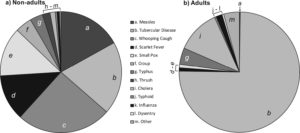Public health has always been a major concern throughout history, but we are, perhaps more than ever, conscious of the importance of not only our health care systems, but our environment and the numerous factors that can contribute to susceptibility and exposure to disease. Numerous studies have shown how urban centres give rise to marked social inequalities, with social and cultural positioning, as well as access to resources and amenities, impacting individual health and wellbeing.
This paper, co-authored with Dr Sophie Newman (Dr Sophie Newman, University of Edinburgh), considers evidence from 19th century London, and the impact that poverty, overcrowding, poor housing, and heavy air pollution had on the health and wellbeing of Londoners at this time. Utilising both historical documentary and skeletal evidence from the burial grounds of St Bride’s Church, Fleet Street, London, this paper explores how increasing urbanisation impacted on non-adult health and survival in nineteenth-century London, specifically addressing how life in the city exacerbated their exposure to infectious diseases. Documentary evidence showed that Measles, Tuberculosis, Whooping Cough, Scarlet Fever, and Smallpox were the primary specific causes of death recorded. Though skeletal evidence does support the notion of severely reduced health status, lesions recorded are unlikely to be a true representation of the extent of poor health, as only 3.47% of the non-adult individuals showed signs of a specific infectious disease. However, a further 18% showed evidence of non-specific new bone formation, whilst 27% showed evidence of cribra orbitalia. Indeed, we must remember that many acute conditions may result in pathological lesions being quick to heal, or result in rapid death, meaning no skeletal lesions were able to manifest.

Please find our open access and freely available publication here: Contagion in the Capital

